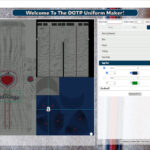Nursing uniforms have journeyed through a fascinating evolution, mirroring societal shifts, medical advancements, and fashion trends across decades. While earlier nursing attire was rooted in practicality and religious dress, the 1950s marked a distinctive era where functionality began to subtly merge with the burgeoning fashion consciousness of the time. This period gave rise to the iconic “50s Nurse Uniform,” a style that continues to evoke images of mid-century healthcare and a particular aesthetic charm.
To truly understand the 50s nurse uniform, it’s essential to glimpse at the styles that preceded it. Initially, nursing wasn’t a formally established profession, and attire was far from standardized. In many instances, care for the sick was a familial duty, with clothing choices being purely practical rather than designed for hygiene or professional identification. Even in early organized nursing facilities, often run by religious orders, uniforms were simply the habits of nuns, prioritizing modesty and religious symbolism over specific nursing needs.
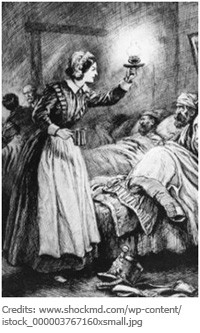 Florence-Nightingale-integrated
Florence-Nightingale-integrated
As nursing transitioned into a recognized profession, the first uniforms borrowed heavily from the nun’s habit, reflecting a sense of sisterhood and dedication. Figures like Florence Nightingale introduced more structure and sanitary practices into nursing, yet the concept of a distinct uniform was still in its nascent stages. During the Crimean War, even Nightingale herself was often pictured in a simple apron over her dress, highlighting the practical yet still evolving nature of nurse’s attire. Early uniforms were largely about modesty and differentiation from everyday clothing, rather than the stylish or distinctly fashionable garments they would later become.
The late 19th and early 20th centuries saw a gradual formalization of nurse uniforms. Aprons and caps became increasingly common. Early pioneers like Lillian Wald, while not always adhering to strict uniform policies, still showcased elements like aprons and caps that were becoming recognizable components of nursing attire. As nursing schools and organizations became more structured, so too did the uniforms, reflecting a growing sense of professional identity and standards.
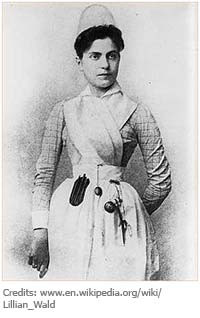 German-Jewish-nurse
German-Jewish-nurse
By the early 20th century, various styles emerged, from nun-like habits adopted by religious nursing schools to more secular designs. Uniforms were often long-sleeved, ankle-length, and made of white or light-colored fabrics, emphasizing cleanliness and a professional appearance. The early 1900s also saw variations in necklines and sleeve styles, and the introduction of features like cuffs and belts for both practical and aesthetic purposes.
World War I and World War II significantly impacted nurse uniforms. During wartime, practicality and resourcefulness became paramount. Uniforms often took on a more military-inspired look, with shorter hemlines and simpler designs due to fabric shortages and the need for functional attire in field hospitals and active service. Fabrics like cotton crepe and wool became common for their durability and practicality in diverse climates and demanding conditions. Military nurses adopted specific uniform regulations, often incorporating insignia and rank indicators.
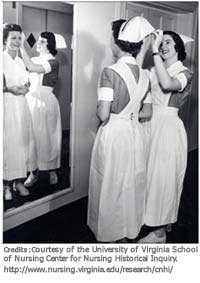 American-nursing-uniforms
American-nursing-uniforms
The post-World War II era and the dawn of the 1950s brought about a shift. With the war’s end, there was a general societal move towards optimism and renewed interest in fashion and femininity. This societal shift subtly influenced the design of nurse uniforms. The “50s nurse uniform” began to take shape, characterized by a blend of professional practicality and the emerging fashion trends of the decade.
The quintessential 50s nurse uniform typically featured a dress that fell to the knees or just below, a departure from the longer, ankle-length styles of earlier periods. Shorter hemlines became more acceptable and practical in the increasingly busy hospital environments. Waistlines were often defined, reflecting the popular dress silhouettes of the 1950s, which emphasized an hourglass figure. Belts were common, cinching the waist and adding a touch of style.
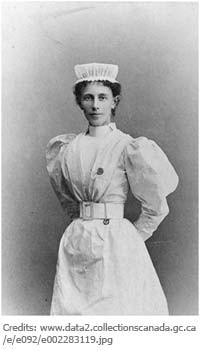 Georgina-Pope-wears
Georgina-Pope-wears
Sleeve styles in 50s nurse uniforms were generally short, often ending around mid-bicep, and sometimes featured cuffs or a slight puff at the shoulder, echoing the fashionable sleeve designs of the era. Necklines remained modest, often rounded or featuring Peter Pan collars, maintaining a professional and approachable appearance. Fabrics were typically cotton or cotton blends, chosen for their washability, comfort, and crisp appearance. White remained the dominant color, symbolizing cleanliness and purity, though pastel shades started to appear in some settings.
Nurse caps remained an integral part of the 50s nurse uniform, though their function shifted more towards symbolic identification rather than strict sanitary purposes. By this time, elaborate and varied cap styles had become commonplace, with each hospital or nursing school often having its distinctive cap design. Caps were worn as a badge of honor and professional identity, signifying a nurse’s training and affiliation.
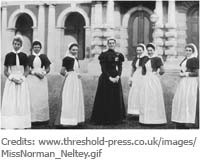 Colonial-Nursing-Association
Colonial-Nursing-Association
Key variations within the 50s nurse uniform style included subtle changes in neckline, sleeve details, and cap styles. Some uniforms featured contrast trims on collars, cuffs, or pockets, adding visual interest to the predominantly white attire. Aprons and pinafores, while still present in some institutions, became less ubiquitous than in previous decades, reflecting a move towards simpler, more streamlined uniform designs. Accessories were generally kept to a minimum, with wristwatches being the most common and practical addition, essential for timekeeping and medication administration.
The 50s nurse uniform, while embodying the fashion sensibilities of the time, still prioritized practicality and professionalism. The knee-length dresses allowed for greater mobility, crucial for nurses constantly on the move. Easy-to-clean fabrics maintained hygiene standards. The overall look was neat, crisp, and conveyed an image of competence and caring that was central to the nursing profession.
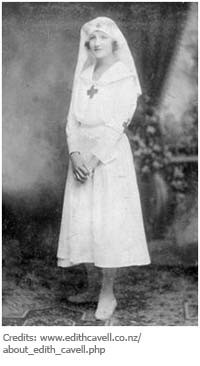 nurse-caps
nurse-caps
The impact of the 50s nurse uniform extends beyond its immediate era. It became a widely recognized and somewhat romanticized image of nursing. The style has been referenced and replicated in popular culture, from movies and television to Halloween costumes, solidifying its place in the collective visual memory of mid-century America. The 50s nurse uniform represents a transitional period in nursing attire, bridging the gap between the very traditional, functional uniforms of the early 20th century and the more modern, less formal styles that would emerge in subsequent decades.
As the 1960s approached, nurse uniforms began another evolution, with hemlines rising further and new fabrics and styles being introduced. However, the 50s nurse uniform remains a significant and fondly remembered chapter in the history of nursing attire. It represents a time when nurse uniforms started to subtly reflect contemporary fashion trends while still upholding the core values of professionalism, care, and dedication inherent in the nursing profession. The enduring appeal of the 50s nurse uniform lies in its classic silhouette, its blend of practicality and style, and its nostalgic association with a particular era in healthcare history.

